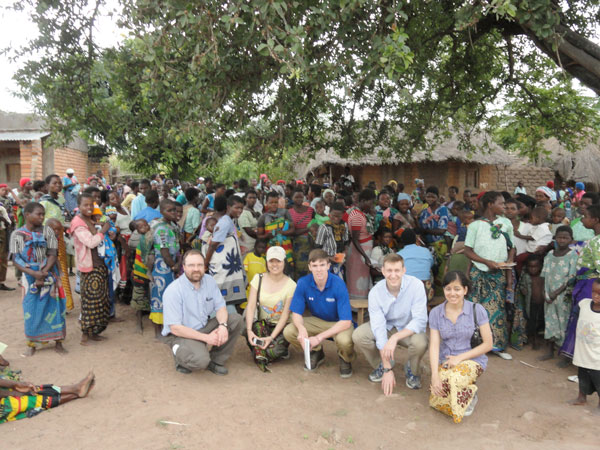
Vaccinations are critical to good health, but to be effective, the vaccines must be refrigerated. In developing countries with little access to electricity to keep the vaccines cold or automobiles to quickly transport them, simply getting vaccines to individuals in need can be a major challenge. That all could change, with the help of a few Case Western Reserve University students.
Four biomedical engineering students—Mihika Gongolli, Aaron Mayer, Colin Morlock and Yaoyu Zhang—along with faculty members Andrew Rollins and Daniel Lacks traveled to Malawi, Africa, over spring break to get an in-person look at the problem and to see how they could help.
In Malawi, only 9 percent of the population has access to electricity, and nearly 85 percent live in rural areas, according to a World Bank report.
To vaccinate these children, health workers from nearby clinics ride bikes up to 10 miles to surrounding villages, where they vaccinate children in makeshift settings—such as under a big shade tree that helps keep the shots cool. To transport the vaccines from the clinic to the village, the workers carry standard coolers like one might take to a picnic.
“There is a real time crunch for the health care workers to ride to the villages and vaccinate hundreds of children in the time that the vaccines remain sufficiently chilled in the cooler,” Lacks explained, noting that there is just a four-hour window for the travel and vaccinations to occur.
But because the vaccines must be stored at such cool temperatures—2 to 8 degrees Celsius, according to Mayer—and there are such limitations on delivery and storage methods, many children don’t get vaccinated, which allows diseases to spread further, Mayer said.

The students’ solution? Create a portable, lightweight, battery-run refrigeration system that is easy to transport and effectively cools the vaccines.
Through their senior design project, the students will make a working prototype of the cooler, which will include an active cooling element and will be light enough so workers can travel with it quickly and easily.
Though a product may not be ready to send to Malawi by the end of the semester, both the students and professors feel it is an important starting point for future student design projects.
Rollins and Lacks, for example, said they identified multiple projects for students in other areas of study, and they want to work with future engineering classes to ensure the cooler prototypes reach Malawi.
Mayer hopes his group can build models to be donated and used by health clinics and outreach workers. Even more, he’d also like to see their approach inspire others.
“What I hope more than anything is that we pave the way for other engineering groups to want to take on projects of this scope,” he said. “If we are able to motivate other students to learn about the world outside the walls of our institution, we multiply the positive effects that our project could have.”
Rollins, an associate professor of biomedical engineering, and Lacks, the C. Benson Branch Professor of Chemical Engineering, noted that showing students the connection between classroom training and real-world results is critical.
“When students have the chance to go abroad and see the problems other people experience, it gives them an expanded view of the world,” Rollins said. “And it gives them an expanded view of engineering—that it’s not just for making money, it’s for solving real problems and improving people’s lives.”

Thinking beyond Case Western Reserve was a key take-home lesson for Mayer and the students. Though they were in Malawi for just five days, they saw much of the day-to-day life of Malawians, thanks to a connection from Rollins, who served in Malawi while in the Peace Corps in the 1990s.
The group visited the health care clinics and vaccination stations, of course, but they also visited three schools, went on a safari and lived sans electricity with a local family. The experience allowed the students to learn much more than just how hard it is to get vaccines to people; they learned about language and cultural barriers, political issues of the country and the lives of the people there—especially their love of education.
“Ultimately, I think the solutions to many of their problems are difficult to solve,” Mayer said. “But the power, I believe, lies in the education of their own people to come up with solutions that allow them to stand on their own and improve their way of life.”
This project is supported in part by the Team-Based Design in Biomedical Engineering program through the National Institute of Biomedical Imaging and Bioengineering of the National Institutes of Health (R25EB014774), and by the National Science Foundation (CBET-1159327).
For a listing of all education abroad opportunities, visit case.edu/studyabroad.
